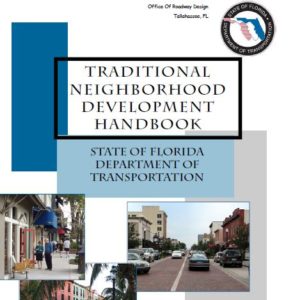The Florida Department of Transportation has used the Traditional Neighborhood Development approach to help communities integrate land use and transportation to achieve increased livability when compared to Conventional Suburban Development, or “business as usual.”
Background
For state DOTs, the challenge to transition from Conventional Suburban Development to Traditional Neighborhood Development often arises when the roadway standards engineers are required to meet for state roads do not provide the flexibility needed to design context sensitive solutions.
Traditional Neighborhood Development typically includes a range of housing types, a network of well-connected streets, public spaces, and a variety of amenities within easy reach of housing.

In 2001, recognizing the need for greater flexibility in design and engineering standards to pursue Traditional Neighborhood Development solutions for communities, Florida revised its “Manual of Uniform Minimum Standards for Design, Construction, and Maintenance for Streets and Highways,” commonly known as the “Florida Greenbook.”
The addition of Chapter 19, Traditional Neighborhood Development, in 2011 to the Florida Greenbook formalized the state’s endorsement of context sensitive approaches to transportation and land use as standard practice. Chapter 19 focuses on network functionality and design standards that support communities. To supplement Chapter 19 and describe the why and how of Traditional Neighborhood Development, Florida DOT published the “Traditional Neighborhood Development Handbook” (2011) providing best practices and facilitating proper design for communities.
Though Florida DOT maintains Chapter 19 and the Traditional Neighborhood Development Handbook, implementation is at the local level. The Florida Greenbook was produced through committees made up of local representatives (e.g., public works directors, consultants, and engineers) while the Traditional Neighborhood Development Handbook was developed over time by experts. The two documents work together to implement the approach.
Lessons Learned
FDOT officials have identified the following key lessons learned from their Traditional Neighborhood Development efforts:
- Balance: It is not easy to balance building state DOT roadways with the needs of the places those roads runs through. Having an established program that supports Traditional Neighborhood Development allows state DOTs to build roads and provide transportation, while simultaneously supporting communities to survive and thrive along roadways.
- Justification: Standards like Chapter 19 and guidance like the Traditional Neighborhood Development Handbook help provide justification and backup for decision-making, such as when an engineer or lawyer needs clear direction on what is supposed to be done and can be done in a given situation. It is important to have roadway standards that match Traditional Neighborhood Development for successful implementation.
- Economic Development: Realizing the potential for streets as economic development. Traditional Neighborhood Development is how you build roads that make money for your community, not just roads that move money through your community.
- Barriers: Without Chapter 19 or the Handbook, many attempts at Traditional Neighborhood Development were running afoul of existing standards. It can be onerous for an engineer to have to apply for design exceptions every step of the way. With Traditional Neighborhood Development in the Florida Greenbook, the pathway is smoother.
- Context: Providing Chapter 19 and the Traditional Neighborhood Development Handbook is one way a state DOT can show it understands the issue of context and encourage communities to consider the issue of matching streets to land use to create complete streets.
There is a common belief that roadway engineering standards are entirely based on safety (e.g., “a 12-foot lane is safer than 10-foot lane”) and apply to all conditions, and that deviations are unsafe. As a result, the flexibility that Chapter 19 and the Traditional Neighborhood Development Handbook provides may be initially received with skepticism by engineers and other community stakeholders.
To help stakeholders learn about the benefits of this flexibility, DOTs and local communities benefit from continued dialogue and discussion to understand the advantages of Traditional Neighborhood Development and to gain support and buy-in at all levels. Working through the changes together with emergency response, public works, and other local government stakeholders builds trust. The collaboration informs state DOTs about where locals are coming from and demonstrates that the state DOT is looking out for their interests.
“The Traditional Neighborhood Development Chapter and Handbook let folks build safe, complete, walkable streets that are normally difficult to do under conventional standards,” said DeWayne Carver, Florida DOT’s Chapter 19 technical expert. “If you want to encourage and permit traditional neighborhood development (new or old), then you need thoroughfare standards to match. The TND standards can help us save the great urban places we have in our state by putting the right roadway design in the right place.”
Current Efforts and Next Steps
Like Florida, other state DOTs are also embracing Traditional Neighborhood Development. North Carolina DOT has TND Street Design Guidelines and Massachusetts DOT completely rewrote their guidance for their entire department and highlights Traditional Neighborhood Development case studies in an online toolbox. Others, like Mississippi DOT and Vermont DOT, are implementing complete streets policies and moving towards similar programs.
At Florida DOT, officials have met with internal and external partners to determine what needs to be done differently to implement a complete streets policy. This will likely include a change in state standards to more closely align with Chapter 19 and the Traditional Neighborhood Development Handbook for locations that can use the approach.
The Florida DOT recognizes that Chapter 19 and the Traditional Neighborhood Development documents will soon be ready for revisiting, especially once Florida state standards are updated with complete streets policy. Committees that include local representatives will again be involved early to discuss and implement any needed updates to the Handbook.
For more information on Florida DOT’s Chapter 19 and Traditional Neighborhood Development Handbook, contact DeWayne Carver, State Bicycle/Pedestrian Coordinator, Roadway Design Office/Florida DOT at [email protected].